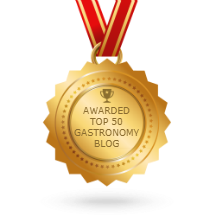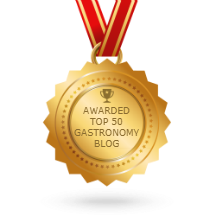* * * * *

Churros cooking in oil at La Mañueta Churrería, Pamplona.
After the encierro on July 14, when we watched the Miuras from an apartment above the Ayuntamiento and calle Mercaderes, with members of the Jorajuria Martín family, to avoid the crowds, we left city hall by going down by the Mercado then to the street, s, where the legendary La Mañueta Churrería is located. I had heard about La Mañueta Churrería for years, but had never been there, let alone tried their churros. I have photographed churrerías all over Spain from Málaga to Ronda to Sevilla and in many villages and cities across Spain, but I had never been to La Mañueta and it was high on my churros bucket list.

La Mañueta Churrería, Pamplona.
When we got to calle Mañueta, alas, the lines to get into La Mañueta Churrería, were two blocks long in either direction. I was with Kay, Enrique Jorajuría (son of my late friend José Ramón Jorajuria and his wife Paquita Martín, Juanito Quintana´s niece), his wife Mari Carmen Ugarte and their friend Ceci Young. I told them to hold our place in line and I marched up to front door and into the churrería, where I told them I was a writer and was working on Volume II of my book Sunset in a Glass: Adventures of a Food and Wine Road Warrior in Spain.

Churrería
"La Mañueta", in operation for more than 150 years, is the oldest
Churrería " in Pamplona, but it is only open for two weekends in June,
every day during the Fiestas de San Fermín from July 6 - 14 and on
Sundays in October.
I was invited to the back of the churrería by the owners Elías and Fermín Elizalde, where the churros were being fried in vats of oil. I got Enrique’s attention and told him to bring the rest of our crew in. Soon, Elías was showing us the entire production process for La Mañueta’s churros. Elías proudly showed us the purifier he uses to makes sure the water that goes into the churro batter is pristine.

Gerry Dawes and Fermín Elizalde, one of the owners of Churrería "La Mañueta".
We were even invited to share several plates of churros fresh out of the fryers and were even treated to chupitos of pachaka, apple patxaran. Even my Pamplona family and amigos were impressed with my panache.

Elías Elizalde, one of the owners of Churrería "La Mañueta", a plate of fresh churros.
Churrería "La Mañueta", in operation for more than 150 years, is the oldest Churrería in Pamplona, but it is only open for two weekends in June, every day during the Fiestas de San Fermín from July 6 - 14 and on Sundays in October.
All photographs by Gerry Dawes©2024.
Comments are welcome and encouraged.
Text and photographs
copyright by Gerry Dawes©2021. Using photographs without crediting Gerry Dawes©2021 on
Facebook. Publication without my written permission is not authorized.
* * * * *
Shall deeds of Caesar or Napoleon ring
More true than Don Quixote's vapouring?
Hath winged Pegasus more nobly trod
Than Rocinante stumbling up to God?
More true than Don Quixote's vapouring?
Hath winged Pegasus more nobly trod
Than Rocinante stumbling up to God?
Poem
by Archer M. Huntington inscribed under the Don Quixote on his horse
Rocinante bas-relief sculpture by his wife, Anna Vaughn Hyatt
Huntington,
in the courtyard of the Hispanic
Society of America’s incredible museum at 613 W. 155th Street, New York
City.
_______________________________________________________________________________________________

In 2019, again ranked in the Top 50
Gastronomy Blogs and Websites for Gastronomists & Gastronomes in
2019 by Feedspot. (Last Updated Oct 23, 2019)
"The Best Gastronomy blogs selected from thousands of Food blogs, Culture blogs and Food Science blogs in our index using search and social metrics. We’ve carefully selected these websites because they are actively working to educate, inspire, and empower their readers with frequent updates and high-quality information."
36. Gerry Dawes's Spain: An Insider's Guide to Spanish Food, Wine, Culture and Travel
About Gerry Dawes
"The Best Gastronomy blogs selected from thousands of Food blogs, Culture blogs and Food Science blogs in our index using search and social metrics. We’ve carefully selected these websites because they are actively working to educate, inspire, and empower their readers with frequent updates and high-quality information."
36. Gerry Dawes's Spain: An Insider's Guide to Spanish Food, Wine, Culture and Travel
About Gerry Dawes
My good friend Gerry Dawes, the unbridled Spanish food and wine
enthusiast cum expert whose writing, photography, and countless
crisscrossings of the peninsula have done the most to introduce
Americans—and especially American food professionals—to my country's
culinary life." -- Chef-restaurateur-humanitarian José Andrés, Nobel
Peace Prize Nominee and Oscar Presenter 2019
Gerry Dawes is the Producer and Program Host of Gerry Dawes & Friends, a weekly radio progam on Pawling Public Radio in Pawling, New York (streaming live and archived at www.pawlingpublicradio.org and at www.beatofthevalley.com.)
Dawes
was awarded Spain's prestigious Premio Nacional de Gastronomía
(National Gastronomy Award) in 2003. He writes and speaks frequently on
Spanish wine and gastronomy and leads gastronomy, wine and cultural
tours to Spain. He was a finalist for the 2001 James Beard Foundation's
Journalism Award for Best Magazine Writing on Wine, won The Cava
Institute's First Prize for Journalism for his article on cava in 2004,
was awarded the CineGourLand “Cinéfilos y Gourmets” (Cinephiles
& Gourmets) prize in 2009 in Getxo (Vizcaya) and received the
2009 Association of Food Journalists Second Prize for Best Food Feature
in a Magazine for his Food Arts article, a retrospective piece about
Catalan star chef, Ferran Adrià.
In December, 2009, Dawes was awarded the Food Arts Silver Spoon Award in a profile written by José Andrés.
".
. .That we were the first to introduce American readers to Ferran Adrià
in 1997 and have ever since continued to bring you a blow-by-blow
narrative of Spain's riveting ferment is chiefly due to our Spanish
correspondent, Gerry "Mr. Spain" Dawes, the messianic wine and food
journalist raised in Southern Illinois and possessor of a
self-accumulated doctorate in the Spanish table. Gerry once again
brings us up to the very minute. . ." - - Michael & Ariane
Batterberry, Editor-in-Chief/Publisher and Founding Editor/Publisher,
Food Arts, October 2009.
Pilot for a reality television series
on wine, gastronomy, culture and travel in Spain.
Experience
Spain With Gerry Dawes: Customized Culinary, Wine & Cultural
Trips to Spain & Travel Consulting on Spain
Gerry Dawes can be reached at gerrydawes@aol.com; Alternate e-mail (use only if your e-mail to AOL is rejected): gerrydawes@gmail.com
Gerry Dawes can be reached at gerrydawes@aol.com; Alternate e-mail (use only if your e-mail to AOL is rejected): gerrydawes@gmail.com
























